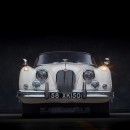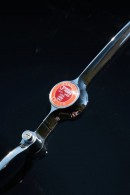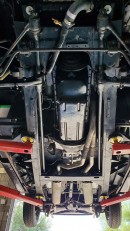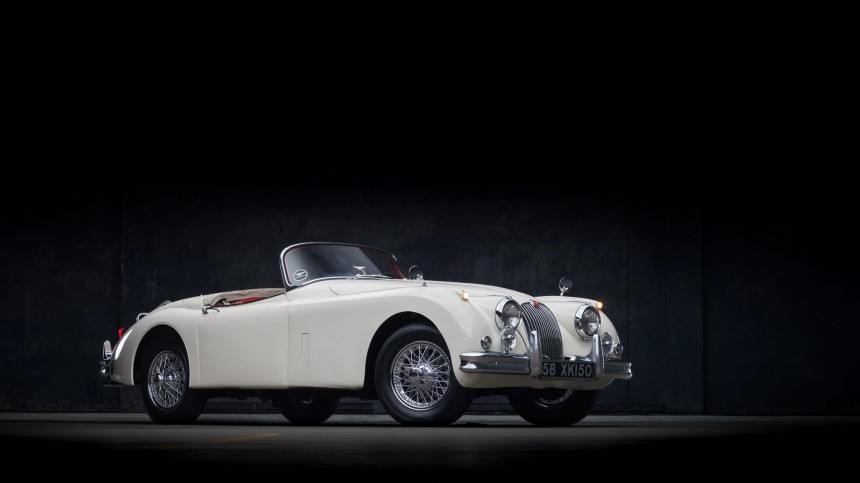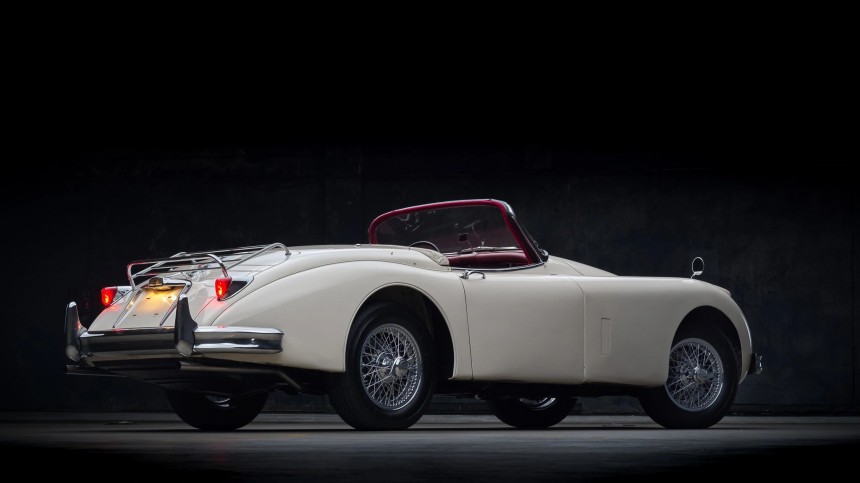Jaguar’s post-war trajectory went from strength to strength. In the realm of sports cars, the Leaping Cat of Coventry struck gold with the record-breaking XK120 that launched at the 1948 London Motor Show alongside the Mark V luxury car. The XK140 followed suit with a few improvements, then the XK line welcomed its last iteration: the gorgeous XK150.
The predecessor of the fabulous E-Type features a box-type steel chassis like its forerunner, a body-on-frame architecture borrowed from the Mark V drop-head coupe. Shorter and lighter, the backbone of the XK150 integrates a Salisbury rear axle with leaf springs and independent front suspension in the form of wishbones. Torsion bars and an anti-roll bar are also featured up front, together with telescopic dampers on every corner.
A tremendous change over the XK140 comes in the guise of Dunlop 12-inch disc brakes fore and aft rather than Lockheed 12-inch drum brakes. The wheel size, however, stays put at 16 by 5.5 inches. Customers had to choose between steelies and wire wheels, but only the steelies could be fitted with cool-looking rear spats. Originally fitted with a 3.4-liter engine, the sexy feline leveled up to a 3.8-liter option at the 1959 London Motor Show.
Every single configuration available flaunts a 14-gallon fuel tank, as in 16.8 gallons in the United States or 63.6 liters if you prefer the metric system. Developed by the William Munger "Bill" Heynes, the man who led the engineering of every single Jaguar from 1935 to 1970, the straight-six engine in the XK150 cranks out 190 horsepower in its most basic form.
Displacing 3,441 cubic centimeters thanks to an 83-millimeter bore and 106-millimeter stroke, the 3.4 uses cast iron for the block and aluminum alloy for the dual-overhead-camshaft head with inclined valves and hemispherical combustion chambers. Indeed, Jaguar was HEMI-ing before Chrysler introduced the FirePower Hemi in 1950 for the 1951 model year.
Lucas Industries coil and single plug ignition, two SU H6 carburetors, and a compression ratio of 8.0:1 pretty much sum up this powerful yet smooth engine. Customers with a need for speed could opt for the B-Type head, which differs from the C-Type head by means of larger exhaust valves. Together with the 9.0:1 compression ratio, twin exhaust system, and high-lift camshafts, this variant cranks out in the ballpark of 210 ponies. Torque also went up from 210 to 216 pound-feet (285 and 293 Nm, respectively).
The 3.4 S, introduced in March 1958 alongside the open-top roadster, belts out 250 horsepower and 240 pound-feet (325 Nm) thanks to three SU HD8 carburetors and a straight port cylinder head. The fastest XK150 at the time, this fellow hits 100 kilometers per hour (62 mph) in seven-odd seconds.
The 3.8 option mentioned earlier features twin HD6s as standard and 220 ponies. As for the range-topping 3.8 S with triple HD8s, the British automaker promises 265 horsepower and 260 pound-feet (353 Nm). In this particular spec, the XK150 can hit 220 kilometers per hour (137 mph).
In terms of extras, the Coventry-based automaker offered things like whitewall tires, a leaping cat hood ornament, a luggage rack and fitted luggage, and underbody armor. Radiomobil radios also have to be mentioned, along with aluminum trim on the dashboard, white or wood-finished steering wheels from Bluemels, a Weathershields sunroof for the fixed-head coupe, as well as a tonneau cover for the very elegant drop-head coupe.
Tipping the scales at approximately 1,447 kilograms (3,190 pounds) for the open-top roadster, the XK150 features centrally-mounted instruments that include a clock integrated within the tachometer. Only the fixed-head coupe features two rear seats that are pretty much useless for seating adults.
Over its relatively short production run, as in 1957 through 1960, the XK150 went through two minor changes. In 1958, concomitantly with the discontinuation of the aluminum-trimmed dashboard that looks like a million bucks, Jaguar upgraded the wire wheels from 54 to 60 spokes.
Produced in both right- and left-hand drive, the XK150 story comes to a screeching halt in November 1960. Four months later, Jaguar introduced the bite-the-back-of-your-hand beautiful E-Type. A little under 9,400 examples were delivered, of which the FHC accounted for 4,450 units.
A tremendous change over the XK140 comes in the guise of Dunlop 12-inch disc brakes fore and aft rather than Lockheed 12-inch drum brakes. The wheel size, however, stays put at 16 by 5.5 inches. Customers had to choose between steelies and wire wheels, but only the steelies could be fitted with cool-looking rear spats. Originally fitted with a 3.4-liter engine, the sexy feline leveled up to a 3.8-liter option at the 1959 London Motor Show.
Every single configuration available flaunts a 14-gallon fuel tank, as in 16.8 gallons in the United States or 63.6 liters if you prefer the metric system. Developed by the William Munger "Bill" Heynes, the man who led the engineering of every single Jaguar from 1935 to 1970, the straight-six engine in the XK150 cranks out 190 horsepower in its most basic form.
Lucas Industries coil and single plug ignition, two SU H6 carburetors, and a compression ratio of 8.0:1 pretty much sum up this powerful yet smooth engine. Customers with a need for speed could opt for the B-Type head, which differs from the C-Type head by means of larger exhaust valves. Together with the 9.0:1 compression ratio, twin exhaust system, and high-lift camshafts, this variant cranks out in the ballpark of 210 ponies. Torque also went up from 210 to 216 pound-feet (285 and 293 Nm, respectively).
The 3.4 S, introduced in March 1958 alongside the open-top roadster, belts out 250 horsepower and 240 pound-feet (325 Nm) thanks to three SU HD8 carburetors and a straight port cylinder head. The fastest XK150 at the time, this fellow hits 100 kilometers per hour (62 mph) in seven-odd seconds.
The 3.8 option mentioned earlier features twin HD6s as standard and 220 ponies. As for the range-topping 3.8 S with triple HD8s, the British automaker promises 265 horsepower and 260 pound-feet (353 Nm). In this particular spec, the XK150 can hit 220 kilometers per hour (137 mph).
Tipping the scales at approximately 1,447 kilograms (3,190 pounds) for the open-top roadster, the XK150 features centrally-mounted instruments that include a clock integrated within the tachometer. Only the fixed-head coupe features two rear seats that are pretty much useless for seating adults.
Over its relatively short production run, as in 1957 through 1960, the XK150 went through two minor changes. In 1958, concomitantly with the discontinuation of the aluminum-trimmed dashboard that looks like a million bucks, Jaguar upgraded the wire wheels from 54 to 60 spokes.
Produced in both right- and left-hand drive, the XK150 story comes to a screeching halt in November 1960. Four months later, Jaguar introduced the bite-the-back-of-your-hand beautiful E-Type. A little under 9,400 examples were delivered, of which the FHC accounted for 4,450 units.





